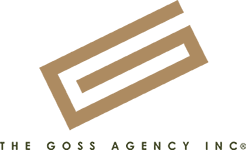Branding
Since everything from a logo to a website is called branding, let’s begin with our definition of branding: The effective identification and communication of your most compelling distinction consistently over time.
We provide a thorough process to exhaust sources for insights in the areas of your company, constituency, and competition to determine your most compelling, valid, sustainable, and competitive distinction. Hey, you’re in a position to create a legendary brand. Let’s do something that will have people congratulating you at the company Christmas party!
Logo/Tagline
The Goss Agency provides a disciplined process for a Brand-centric, lasting logo: The logo development process begins with a Creative Brief defining the Brand positioning/key message of the Brand with supporting facts, copy points, colors, textures, icons, graphics, product features, historic symbolism, etc. The logo concepts are designed with a specialized art execution style in mind.
Corporate Identity
Once we have designed the logo, we communicate the brand effectively throughout all of the materials that are necessary for day-to-day business (business cards, letterhead, email signature, etc.)
Context Analysis
This will report salient findings from all previous learning and recommend a set of top-line strategies for implementation.
Stakeholder/Influencer Interviews
60-minute, face-to-face interviews using an interview guide forwarded to participants ahead of meeting time. Ideally, interview subjects would include “Brand stakeholders” who will have a vested interest in the outcome of the campaign. This survey will include target understanding, assessments of current Brand/marketing, expected outcome from a greater focus on investment in Branding and potential ideas which should be included.
External Interviews
We conduct a “soft-sounding” of 10 interviews with “experts/influencers” who are connected to the brand. These interviews are generally 30-45 minutes in length. We will prepare a topic guide in advance and forward to participants.
Brand Audit
Review existing print and digital (web) Branding tactics. These might include efforts made by the brand and/or associations that are relevant to the brand promotion activity. We will perform a “Context Analysis” of all available material which are deemed to be part of Branding.
Competitive Analysis
This is a competitive or “peer group” analysis of four brands in the industry that are within a brand’s peer group. The goal here is to understand how competitors go to market with respect to Branding Strategy, tactical messaging and use of various media channels. We use many of the same analytical techniques used in the Brand Audit, allowing benchmarking of the brand to the peer group.
Brand Workshop
Five-hour workshop featuring “Sparks” and “Pro-File.” These tools use projective techniques to elicit thinking from a group of 12-20 “subject-matter experts.” We will begin by presenting a short summary of findings from the leadership and external interviews and then facilitate the “Sparks” and “Pro-File” sessions. Sparks is a Brand inventory tool that generates a large number of ideas and “Brand opportunity statements” for further evaluation using validity/motivation/differentiation criteria.
Pro-File uses collaging techniques to team-build profiles of key market segments. These might include: families, Millennials and Affinity Targets.
Segmentation Analysis
A factor analysis of U.S. households by desired geographic area. Every household is sorted into one of 66 discrete “clusters” based on an aggregation of data from many consumer databases such as Nielsen Household Data, Simmons or R.L. Polk.
Brand Health Study
A quarterly, biannual or annual quantitative study tracking key indicators of brand awareness, brand image, brand recall among primary competitors, as well as barriers to entry, source, and Promoter Score (likelihood to recommend).
Alternative Brand Narratives
Five to 10 alternative Brand concepts. We will help guide evaluation of the alternatives by suggesting a set of criteria. Collecting feedback in the meeting for final recommendation on “Brand Architecture.”
Focus Groups
We conduct three focus groups in DMA to gain a “market perspective” on a subset of Brand Narratives and, possibly, other executional elements and benefits/barriers.
Final Brand Architecture & Positioning
Recommended Brand strategy, Brand DNA statement and a message matrix identifying market segment/target, need state, key message points, programming ideas, and top-line outreach recommendations.
Brand Strategy
Identification of most compelling distinction through analysis of the destination features, benefits, and experiences, competitive set/positioning, constituent perspectives/ behavior/desires/barriers. Studies of the Brand Discovery findings.
Strategic Plan
Our strategic planning process ensures that clients get the results they desire. Following a thorough “context analysis,” in which the factors that will impact plan success are identified, the agency works closely with clients to establish goals and determine the metrics by which goal attainment will be measured. Our process is thorough, collaborative, and creative. TGA marketing plans allow clients to create marketing priorities, understand how brand campaigns will be implemented, and track results.
Secondary Scan
Review existing research and conduct a web search for industry studies, etc. Deliverable: Deck-style summary of findings, implications for Branding, and identification of areas where more information is needed.
